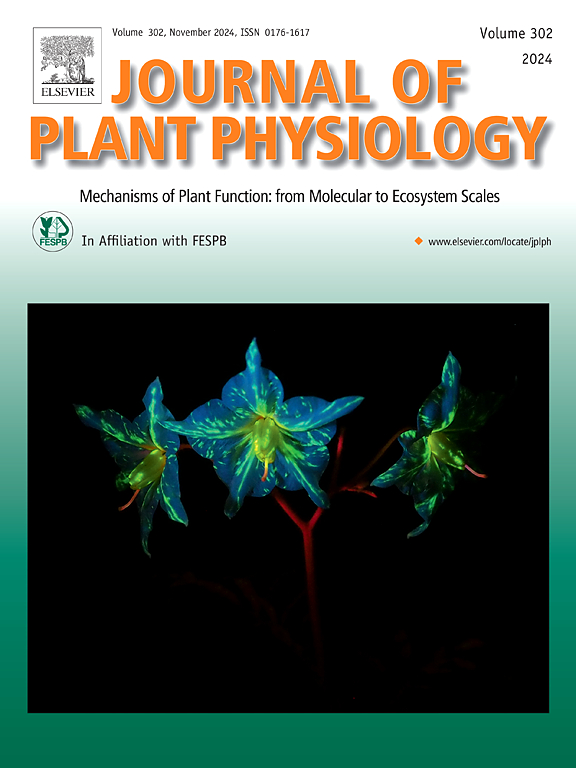Functional characterization of CtWRKY70 transcription factor from Cynanchum thesioides in salt and drought stress resistance
IF 4.1
3区 生物学
Q1 PLANT SCIENCES
引用次数: 0
Abstract
The WRKY transcription factor CtWRKY70 from Cynanchum thesioides was functionally characterized to explore its role in abiotic stress responses. CtWRKY70, encoding a 340-amino acid protein from the WRKY Group III subfamily, localizes to the nucleus and exhibits transcriptional activation activity. Its expression is significantly induced by salt and drought stress. Overexpression of CtWRKY70 in Arabidopsis improved tolerance to both stresses, as evidenced by enhanced survival rates, maintained biomass, and preserved chlorophyll content. Transgenic lines exhibited elevated antioxidant enzyme activities (SOD, CAT, POD) and increased proline accumulation, with CtWRKY70 directly bound to the promoter of the AtSOD1 gene as confirmed by electrophoretic mobility shift assay (EMSA) and yeast one-hybrid (Y1H) assays, indicating enhanced ROS scavenging and osmoregulation. In contrast, CtWRKY70-silenced plants showed heightened stress sensitivity, characterized by greater wilting, increased stomatal aperture, and accelerated water loss. Y2H and BiFC assays confirmed the interaction of CtWRKY70 with another stress-responsive WRKY protein, CtWRKY41. These results demonstrate that CtWRKY70 positively regulates drought and salt tolerance by coordinating antioxidant defense and osmotic adjustment. This study provides valuable insights into the molecular mechanisms of WRKY-mediated stress adaptation in horticultural species, positioning CtWRKY70 as a potential genetic target for improving crop resilience.
cynanchides CtWRKY70转录因子在盐和干旱胁迫抗性中的功能研究
对Cynanchum thesioides中WRKY转录因子CtWRKY70进行功能鉴定,探讨其在非生物胁迫应答中的作用。CtWRKY70编码一个来自WRKY III亚家族的340个氨基酸的蛋白,定位于细胞核并表现出转录激活活性。盐胁迫和干旱胁迫显著诱导其表达。CtWRKY70在拟南芥中的过表达提高了对这两种胁迫的耐受性,这可以通过提高存活率、维持生物量和保持叶绿素含量来证明。转基因系表现出抗氧化酶(SOD、CAT、POD)活性升高和脯氨酸积累增加,电泳迁移转移试验(EMSA)和酵母单杂交(Y1H)证实,CtWRKY70直接与AtSOD1基因的启动子结合,表明ROS清除和渗透调节能力增强。相比之下,ctwrky70沉默植株表现出更高的胁迫敏感性,表现为更严重的萎蔫、气孔开度增加和水分流失加速。Y2H和BiFC实验证实了CtWRKY70与另一种应激性WRKY蛋白CtWRKY41的相互作用。这些结果表明,CtWRKY70通过协调抗氧化防御和渗透调节,积极调节抗旱性和耐盐性。该研究为了解wrky介导的园艺物种逆境适应的分子机制提供了有价值的见解,将CtWRKY70定位为提高作物抗逆性的潜在遗传靶点。
本文章由计算机程序翻译,如有差异,请以英文原文为准。
求助全文
约1分钟内获得全文
求助全文
来源期刊

Journal of plant physiology
生物-植物科学
CiteScore
7.20
自引率
4.70%
发文量
196
审稿时长
32 days
期刊介绍:
The Journal of Plant Physiology is a broad-spectrum journal that welcomes high-quality submissions in all major areas of plant physiology, including plant biochemistry, functional biotechnology, computational and synthetic plant biology, growth and development, photosynthesis and respiration, transport and translocation, plant-microbe interactions, biotic and abiotic stress. Studies are welcome at all levels of integration ranging from molecules and cells to organisms and their environments and are expected to use state-of-the-art methodologies. Pure gene expression studies are not within the focus of our journal. To be considered for publication, papers must significantly contribute to the mechanistic understanding of physiological processes, and not be merely descriptive, or confirmatory of previous results. We encourage the submission of papers that explore the physiology of non-model as well as accepted model species and those that bridge basic and applied research. For instance, studies on agricultural plants that show new physiological mechanisms to improve agricultural efficiency are welcome. Studies performed under uncontrolled situations (e.g. field conditions) not providing mechanistic insight will not be considered for publication.
The Journal of Plant Physiology publishes several types of articles: Original Research Articles, Reviews, Perspectives Articles, and Short Communications. Reviews and Perspectives will be solicited by the Editors; unsolicited reviews are also welcome but only from authors with a strong track record in the field of the review. Original research papers comprise the majority of published contributions.
 求助内容:
求助内容: 应助结果提醒方式:
应助结果提醒方式:


